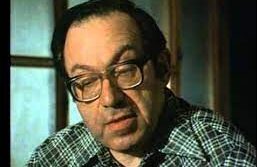Raul Hilberg’s self-destruction
R. Hilberg began his work in 1948 (“My work began in 1948”, 1st edition, p. vi). He published it in 1961. In 1985 he published the “revised and definitive edition”.
In January 1985, at the Zündel trial in Toronto, he had to admit that he had not visited a single German concentration camp (except Auschwitz once in 1979 for a one-day ceremony).
“Basically I am an empiricist”: that is what he claimed to be when examined in June 1984 (Transcripts of the Preliminaries, p. 108, line 24). The context shows that he meant: “My reliance for information rests upon documents, testimony, more than it does on questions I ask of people” (lines 24-26).
R. Hilberg, like Pierre Vidal-Naquet, is a kind of what I call a “paper historian”.
Now, how does he read papers and words (without paying any attention to other items which in this particular matter should perhaps interest an empiricist)? Does he act normally or with what Arthur Butz has called a “remarkable cabalistic mentality”?
At the beginning of his own book the latter goes on to write:
Still possessing my lingering doubts I sat down, early in 1972, and started to read some of the “holocaust” literature itself rather more systematically than I had previously, in order to see just what claims were made in this connection and on what evidence. Fortunately, one of my first choices was Raul Hilberg’s The Destruction of the European Jews. The experience was a shock and a rude awakening, for Hilberg’s book did what the opposition literature could never have done. I not only became convinced that the legend of the several million gassed Jews must be a hoax, but I derived what turned out to be a fairly reliable “feel” for the remarkable cabalistic mentality that had given the lie its specific form (those who want to experience the “rude awakening” somewhat as I did may stop here and consult p. 567-571 of Hilberg) (The Hoax of the Twentieth Century, Foreword).
I agree that pages 567-571 are most characteristic. I should say, by the way, that they are also the climax of the entire demonstration coming from Hilberg in his effort to prove that there was a “destruction of the European Jews”. And the very “heart of the heart”, the “core of the core”, the exact centre of this demonstration is to be found in an 83-word passage at the top of page 570. (In the 1985 “revised and definitive edition” the passage is on pages 890-891.)
Almost the whole Auschwitz supply was needed for the gassing of people; very little was used for fumigation. The camp administration itself did not buy the gas. The purchaser was Obersturmführer Gerstein, Chief Disinfection officer in the Office of the Hygienic Chief of the Waffen-SS (Mrugowski). As a rule, all orders passed through the hands of TESTA, DEGESCH, and Dessau. From the Dessau Works, which produced the gas, shipments were sent directly to Auschwitz Extermination and Fumigation Division (Abteilung Entwesung und Entseuchung).
One morning, as Hilberg was on the witness stand, we told him that Entwesung meant “extermination of vermine”. That afternoon he came back with a German/English dictionary which contained not the word Entwesung but the common word Wesen, and he claimed that Ent-Wesung meant the suppression of “any living being”. That is an unhoped-for example of a “remarkable cabalistic mentality”. Etymology is one thing, meaning is another. Entwesung means “extermination of vermin” and nothing else (see in the same context “exterminator” for “disinfestor”).
The author would have us believe that the Germans had, in the Auschwitz camp, an “Extermination [of inmates] and Fumigation [of quarters and clothing] Division”.
December 30, 1998

